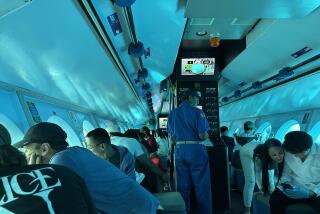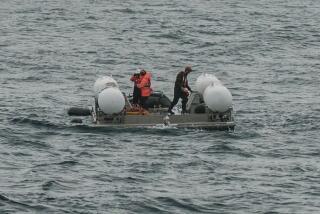Look Below the Surface in Probe of Sub Tragedy
- Share via
There have been two sides to the story of the nuclear submarine Greeneville’s tragic collision and sinking of the Ehime Maru off Honolulu. One has been generated by the press, by current and former Navy officials who have made a variety of uninformed inflammatory comments and by civilians who either were on the Ehime Maru or who are relatives of those who died. The other side has been the trickling of factual data that refute or correct the errors made by those with little or no knowledge of submarine operations. The manner in which press reports have fueled the first side of the story while almost suppressing the second is disgraceful. Cases in point:
* Adm. Thomas B. Fargo’s reported statement that he could not understand “how did they not see it” is widely publicized as implying the failings of the crew or captain. Since Fargo, commander of the U.S. Pacific Fleet, wasn’t on the submarine at the time of the periscope search for surface activity, and since everybody in the control room of the Greeneville has confirmed that a 360-degree periscope search was followed by a second 360-degree periscope search, followed by a third 360-degree periscope search by Cmdr. Scott Waddle himself, what does Fargo suggest? A fourth search? During his time on submarines, did Fargo mandate four searches before each surfacing? Since he has been Pacific commander, has he mandated four searches for all submarine captains before surfacing? What has he mandated to ensure that ships on the surface should be seen?
* The press repeatedly calls the Ehime Maru a 190-foot fishing trawler, implying that it should have been easily seen from the submarine. If the ship was heading directly toward or away from the Greeneville, however, its silhouette may have been as small as 25 feet. Considering likely submarine speed, this small image could have been as far as five nautical miles away, extremely low on the horizon, easily blending into the Oahu background topography and easily obscured by the eight-foot swell on that day. It does not take much imagination to consider the difficulty of spotting, while driving during a rainy day, a small object five miles away.
* Civilians on board the submarine have been headlined as one of the most shocking aspects of this accident. And yet there is not a shred of credible evidence that the civilians had anything to do with the collision. Furthermore, civilians aboard the Greeneville off Oahu have confirmed for the press my own observations off San Diego. At least two of the civilians have reported the Greeneville crew to be superbly professional in every way. They observed the crew to be justifiably proud of their professionalism and of their ship. If we remove civilians from our military vessels, we lose the nonmilitary oversight that keeps us better informed and we regress back to the dark days of the Cold War. The Navy (including Fargo) handed Waddle the civilians, and the captain did his best to educate them about submarine operations.
The biggest mistakes the Navy could make after this tragedy would be to submit to political pressures, to chant Navy mantra about traditions that are overdue for modification or to yield to the clamoring of those who are poorly informed. If Waddle is removed from his command as a result of these pressures, the Navy loses, the free world loses and the submarine forces lose one of the most competent captains to serve our country. Those of us who have traveled on his ship know this commanding officer to be one of the “best of the best.” A civilian on the Greeneville stated it well, as he observed that there was nothing on the submarine that Waddle was not aware of. His competence, his pride of crew and submarine, his remarkable intelligence and his knowledge of Greeneville operations all represent qualities the Navy should do everything possible to sustain, not cast away as an inappropriate response to this tragedy.
An appropriate response by the Navy to the sinking of the Ehime Maru would be to establish appropriate surfacing procedures and areas similar to the “no-fly” zones north of Santa Barbara for Vandenburg Air Force Base. These restricted zones, clearly marked on aviation maps, could have a submarine counterpart on ocean maps, protecting all surface craft from similar disasters in the future.
More to Read
Sign up for Essential California
The most important California stories and recommendations in your inbox every morning.
You may occasionally receive promotional content from the Los Angeles Times.













